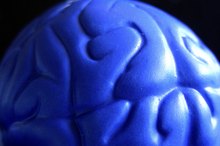Characteristics of Hearing Impairment and Deafness in Children
Hearing impairment is a common but serious problem affecting children of all ages. According to the Palo Alto Medical Foundation, roughly 2 percent of children suffer from some degree of hearing loss 1. Without prompt and effective treatment, hearing loss can cause a child to suffer from significant speech delays, social problems and educational challenges. Hearing impairment and deafness generally manifest with specific symptoms and characteristics. Although symptoms vary among children, certain traits and behaviors are characteristically indicative of hearing difficulties.
If you are experiencing serious medical symptoms, seek emergency treatment immediately.
Speech Delays
Delays in the development of speech and language are classic symptoms of hearing loss and deafness in children 1. The Palo Alto Medical Foundation notes that many children are first diagnosed with hearing impairment in infancy or as toddlers 1. Children who do not say single words by age 1 or two-word phrases by age 2 might suffer from hearing loss. A toddler with normal hearing can typically name familiar objects, follow simple commands, and recognize the names of family members by 15 to 24 months of age. Children with poor hearing might be unable to communicate because they can not understand or imitate spoken language. When diagnosed and addressed early, children with early childhood speech delays generally catch up to their peers.
- Delays in the development of speech and language are classic symptoms of hearing loss and deafness in children 1.
- A toddler with normal hearing can typically name familiar objects, follow simple commands, and recognize the names of family members by 15 to 24 months of age.
Communication Difficulties
Symptoms of Tourette's in Babies
Learn More
Children with mild to moderate hearing impairment may develop speech and language at roughly the same time as their peers. However, they might still struggle to communicate and speak normally. According to the Palo Alto Medical Foundation, children who are preschool-aged and older might manifest language-related symptoms of hearing loss such as responding inappropriately to questions or experiencing difficulty articulating themselves 1. The child might also have a peculiar voice, intonation, pattern of speech or challenges with pronunciation.
- Children with mild to moderate hearing impairment may develop speech and language at roughly the same time as their peers.
- According to the Palo Alto Medical Foundation, children who are preschool-aged and older might manifest language-related symptoms of hearing loss such as responding inappropriately to questions or experiencing difficulty articulating themselves 1.
Selective Hearing
Although it is relatively normal for children to "tune out" some statements or commands from adults in authority, many children who seem to ignore their parents are unable to hear them. The American Academy of Pediatrics reports that children with hearing loss might be able to hear certain sounds and pitches 2. Hearing-impaired children are often unable to hear their names when called, and their behavior can be mistakenly labeled as inattention or behavioral misconduct. A hearing test or developmental evaluation can help to determine the cause or nature of a child's selective hearing.
- Although it is relatively normal for children to "tune out" some statements or commands from adults in authority, many children who seem to ignore their parents are unable to hear them.
- Hearing-impaired children are often unable to hear their names when called, and their behavior can be mistakenly labeled as inattention or behavioral misconduct.
Behavioral Characteristics
Autism Symptoms in an 8-Year-Old Child
Learn More
Deaf and hearing-impaired children can develop a variety of behavioral symptoms. Many children will turn up TVs or radios to an inappropriate volume in an attempt to compensate for their sensory challenges. Children struggling with deafness may also closely watch their peers to emulate behavior and body language -- a symptom known as echopraxia. The American Academy of Pediatrics notes that hearing-impaired children might appear dizzy or disoriented because the nerves in the ears also control balance 2. Academic problems and irritability are also common symptoms of hearing loss in children 1.
- Deaf and hearing-impaired children can develop a variety of behavioral symptoms.
- The American Academy of Pediatrics notes that hearing-impaired children might appear dizzy or disoriented because the nerves in the ears also control balance 2.
Differential Diagnosis
Some children who appear to have the characteristics of hearing loss might suffer from unrelated disorders. Behavioral and emotional disturbances can cause speech delays and social difficulties, which might be mistaken for challenges with hearing or sensory processing. Autism also manifests with many symptoms similar to hearing loss, including selective hearing, language delays and abnormal speech patterns, according to MayoClinic.com 3. Only a professional evaluation can correctly identify the cause of these symptoms and characteristics.
- Some children who appear to have the characteristics of hearing loss might suffer from unrelated disorders.
- Autism also manifests with many symptoms similar to hearing loss, including selective hearing, language delays and abnormal speech patterns, according to MayoClinic.com 3.
Related Articles
References
- Palo Alto Medical Foundation: Hearing Loss in Children
- American Academy of Pediatrics: Hearing Loss
- MayoClinic.com: Autism -- Symptoms
- American Academy of Otolaryngology-Head and Neck Surgery. Infant Hearing Loss.
- American Speech-Language-Hearing Association. Effects of Hearing Loss on Development.
- CDC. Hearing Loss in Children.
- Michigan Medicine. Speech and Language Delay Disorder.
- NCBI. Hearing impairment and language delay in infants: Diagnostics and genetics.
Writer Bio
Juniper Russo, an eclectic autodidact, has been writing professionally since 2008. Her work has appeared in several online and print-based publications, including Animal Wellness. Russo regularly publishes health-related content and advocates an evidence-based, naturopathic approach to health care.









